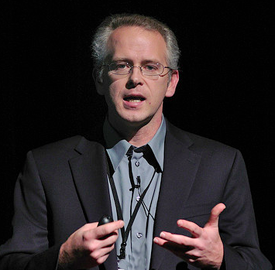David Wiley delivered one of the general session addresses for the 2011 ELI conference on Tuesday Feb 15.
An associate professor of Instructional Psychology and Technology at Brigham Young University, Wiley began his presentation profiling the fundamental purpose of education which at its core is about sharing, "giving it away". This concept served as the foundation for the rest of his talk.
Prior to the digitization revolution, sharing of content was bounded by what Wiley called 'rivalrous resources'. For example, a book can only be lent to one person at a time, however if one posts a textbook online, the whole world can read it - simultaneously. The digitization of content has allows sharing to be non-rivalrous.
This opening up of educational content has, according to Wiley, given educators the opportunity as well as the responsibility to make education open and available to all. Wiley then outlined the various styles and flavors of open educational resources currently available. From online textbooks to OCW repositories to OER recommendors, there is a panoply of ways to access and use open educational content.
 The more difficult challenge is how to measure and accredit learning in the new open world. Several pilot initiatives are tackling this issue. Western Governors University offers no courses but instead gives accredidation tests that certify mastery of a particular topic or discipline. University of the People offers a similar service and charges for the tests on sliding scale according to the economic status of the student's country. A student from Guatamala may pay $10 for a test, while one from Sweden may pay $75 for the same test.
The more difficult challenge is how to measure and accredit learning in the new open world. Several pilot initiatives are tackling this issue. Western Governors University offers no courses but instead gives accredidation tests that certify mastery of a particular topic or discipline. University of the People offers a similar service and charges for the tests on sliding scale according to the economic status of the student's country. A student from Guatamala may pay $10 for a test, while one from Sweden may pay $75 for the same test.
 Finally, Wiley talked about data mining and the importance of leveraging analytics so educators can know what students are learning, how effectively they are learning, and what they are doing to acquire that learning. One of the most remarkable images of Wiley's talk was a 'waterfall' graphic - an aggregate of the measurement of student time spent on the LMS of Utah Open High School. Student time spent on the LMS correlated to student academic performance: the waterfall showed more density at the top of the 'fall' and less towards the bottom, thus illustrating that the more time a student spent in the LMS, the more likely they were to gain a higher grade in the class.
Finally, Wiley talked about data mining and the importance of leveraging analytics so educators can know what students are learning, how effectively they are learning, and what they are doing to acquire that learning. One of the most remarkable images of Wiley's talk was a 'waterfall' graphic - an aggregate of the measurement of student time spent on the LMS of Utah Open High School. Student time spent on the LMS correlated to student academic performance: the waterfall showed more density at the top of the 'fall' and less towards the bottom, thus illustrating that the more time a student spent in the LMS, the more likely they were to gain a higher grade in the class.
After Wiley's talk, the group discussion at MIT centered on the applicability of Wiley's concepts to the humanities and arts. While it was clear that STEM education, with clear skill-sets (especially in the introductory courses), could embrace Wiley's analytics, there were questions as to whether it would work as well in the humanities and arts where performance evaluation is more subjective.
The group also talked about 'inverted pedagogy': the practice of switching class time and homework time, with class time used for questions and help with homework, and homework time spent watching the lecture video online.
Did you attend Wiley's ELI talk? Did you watch it online? Login and let us know your thoughts and reflections...
Prof Wiley's photograph courtesy WayneKlin.